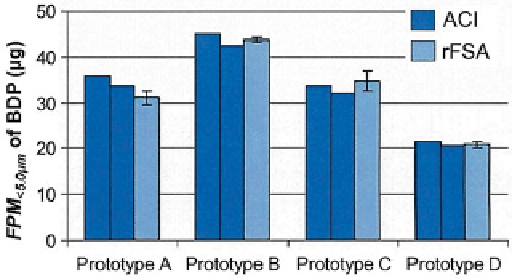Biomedical Engineering Reference
In-Depth Information
Fig. 10.17
Comparison of values of
FPM
<5.0μm
achieved by aerosolizing BDP (100
μ
g per actua-
tion/50
L metered volume) with novel prototype actuators A-D: series 1 and 2 refers to the two
ACI measurements (
n
= 2) shown separately: series 3 refers to the rFSA measurements (
n
= 3), in
which mean ± SD is illustrated for group (
From
[
28
]—
used with permission
)
μ
In the second phase of their investigation, four prototype actuators were assessed
using a standard procedure (
n
= 2; ACI) and rFSA method (
n
= 3) in order to deter-
mine the screening capability of the rapid method. The trend in
FPM
<5.0μm
observed
between prototypes A-D was found to be independent of the impactor method, with
prototype B delivering the optimal dose (Fig.
10.17
).
Keegan and Lewis observed that their rFSA method reduced the time taken to
obtain replicate ACI measurements by 50%. This time saving was in addition to
other reported benefits such as reduced solvent consumption, analysis time, and
data processing. They concluded that their AIM-based methodology represents a
sufficiently precise method for determining key particle distribution metrics such as
FPM
<5.0μm
for the purpose of screening and design optimization studies.
In their second investigation [
29
], Keegan and Lewis turned their attention to the
use of their FSA as a tool for the rapid screening of solution pMDIs containing
increasing concentrations of ethanol. The effect of adding 1.3% w/v glycerol was
also investigated with the preparation containing 13% ethanol. The general test pro-
cedure used by Keegan and Lewis was similar to that for the full FSA method
described in their first study [
28
].
An additional spacing stage was included above the first impaction stage in the
FSA, as recommended by Mitchell et al
.
(see Fig.
10.4
) [
20
] for some measure-
ments. In this modified FSA (mFSA) configuration, more time was allowed for
ethanol to evaporate, with the aim of achieving closer agreement with full-resolution
benchmark ACI measurements for these MDI products. However, this annular
spacer stage differed from the approach adopted by Mitchell et al
.
, in that it con-
sisted of a metal ring without the nozzle plate (Fig.
10.18
).
The MDIs, again containing BDP as API (100
L metered
volume), were manufactured containing 8%, 13%, and 26% w/w ethanol in HFA134a
propellant. Each MDI was equipped with the same actuator as used in their first
study. Values of
CPM
>5.0μm
,
FPM
<5.0μm
, and
EPM
<1.0μm
obtained from each of the
μ
g per actuation/50
μ

Search WWH ::

Custom Search